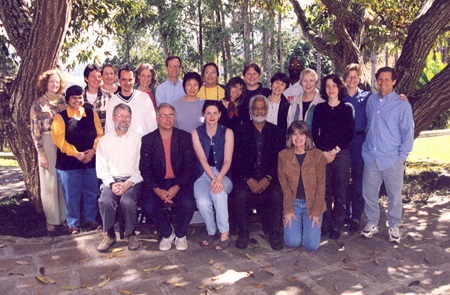Anthropology in the Age of Genetics: Practice, Discourse, Critique
Date
Jun 11-19, 1999Organized by
Alan Goodman and Deborah HeathLocation
Hotel Rosa Dos Ventos, Teresópolis, BrazilPublications
Genetic Nature/Culture (Alan H. Goodman, Deborah Heath, and M. Susan Lindee, Eds.), University of California Press, 2003.Participants
- Troy Duster University of California, Berkeley, USA
- Morris Foster University of Oklahoma, USA
- Sarah Franklin Lancaster University, USA
- Joan Fujimura Stanford University, USA
- Alan Goodman Hampshire College, USA
- Donna Haraway University of California, Santa Cruz, USA
- Deborah Heath Lewis and Clark College, USA
- Chaia Heller University of Massachusetts, USA
- Frederika Kaestle University of Michigan, USA
- Ricky Kittles Howard University, USA
- Erin Koch New School for Social Research, USA
- Susan Lindee University of Pennsylvania, USA
- Jonathan Marks University of California, Berkeley, USA
- Rayna Rapp New School for Social Research, USA
- Hilary Rose City University, London, UK
- Ricardo V. Santos Escola Nacional de Saúde Pública, Brazil
- Sydel Silverman Wenner-Gren Foundation, USA
- Himla Soodyall University of the Witwatersrand, South Africa
- Alan Templeton Washington University, USA
- Carol Worthman Emory University, USA
ORGANIZER’S STATEMENT: The “Anthropology in the Age of Genetics” symposium brought together 19 international scholars. Three groups were almost equally represented: biological anthropologists, sociocultural anthropologists and individuals in allied fields including history, sociology, human genetics and evolution. With the increased pace of genetic research and findings, and increased popularization of these findings, the main aim of the conference was to begin to evaluate how anthropologist are using, responding to, and studying genetic practices and discourses. What are the roles and responsibilities of anthropology and anthropologists in the “age of genetics?
Genetics has most clearly entered anthropology in two very different locations. Genetic methods are increasingly used by biological anthropology to better understand patterns of relatedness among individuals, populations, and species. Simultaneously, cultural anthropologists are studying genetic practices and discourses: in the laboratory, in clinical practices and in wider, corporate and public venues. Here we see how genetic knowledge is transmitted, valorized, and responded to. The symposium was designed to explore the various ways that genetics is being practiced and critically considered within the subdisciplines of biological and sociocultural anthropology. It also provided a unique opportunity to transcend the “Science Wars,” the popular idea that scientific approaches within and beyond anthropology are warring with more relativistic and social constructionist approaches to knowledge.
To further provide an opportunity for dialogue across fields and subdisciplines, we endeavored to include individuals in panels from different subdisciplines and perspectives. Specific panels were on: medical genetics (Lindee, Foster and Rapp), microevolutionary studies (Kaestle, Kittles and Soodyall), race and difference (Templeton, Duster and Worthman), genetic practices and manipulation of animals, including cloning (Haraway, Marks, Franklin), and genetics practices in transnational webs (Santos, Fujimura, Rose, Heller). Four workgroups also took place for a day, focusing on “Revisiting Race, Again,” “Engaging Public Policy,” “Implications for Anthropology,” and “Teaching Anthropology and Genetics.” Finally, the symposium was bracketed by half days focused on the questions “Is this an age of genetics?” and “Is this the age of geneticization?”
The symposium was successful in meeting the goals of providing a current assessment of the various locations that genetics is entering into anthropology and how anthropologist might respond in an age of genetics and geneticization. Exceptional demonstrations were provided of genetic practices in fields and clinics in the 1960s among the Yanamamo and the Amish, thus providing an historical comparison to current genetic practices on/with genetically modified organisms (GMOs), dogs, sheep, chimps, “little people,” Native Americans, Icelanders and practices in Japan. Direct study of nucleotide sequences is providing a clearer and less ambiguous picture of genetic relatedness. For example, Kittles showed how his work is uncovering the hidden origins of enslaved Africans. An important discussion addressed how races are not real in an evolutionary sense, but racializing discourses and racism are real. Other useful cross-panel discussions focused on how to respond to geneticization (the gap between genetic knowledge and discourse) and the potential for activism and intervention, in addition to description and analysis. Participants went well beyond polarized and stereotypic positions of science and antiscience to seeing how nature, for example, is both socially constructed and real.
The greatest success of the session was the sustained dialogue across subdisciplines. We are planning follow-up sessions at the meetings of the American Anthropological Association in 2000. A volume scheduled for publication in the late spring of 2001.
Wenner-Gren Symposium #124
